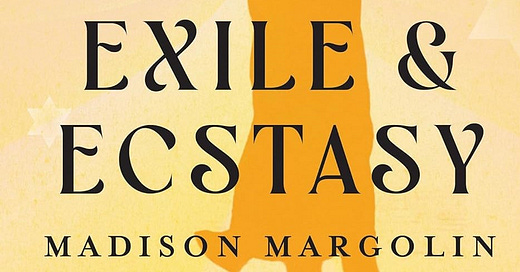In her memoir about psychedelics and Judaism, Madison Margolin, co-founder of DoubleBlind Magazine, argues even the Torah has an acid test: ‘Does it set you freer? Or trap you further?’ This is the question, Margolin suggests in Exile and Ecstasy, we should ask about both religion and psychedelics.
Margolin finds ample connections between Judaism—even its most conservative interpretations—and contemporary psychedelic philosophy, ultimately arguing that Judaism, like many religions, holds keys to understanding altered states of consciousness. ‘The Jewish religion, at least for me, all of a sudden became one giant trip tale, a collective psychedelic journey of a people thrown into the trippiest of all trips—a never-ending wrestling match with the guy in the sky, “chosen” for a struggle that would teach us to strive to thrive, rather than just survive’.
Margolin, the daughter of California cannabis lawyer Bruce Margolin, made her way as a journalist covering the Jewish psychedelic underground, writing for Rolling Stone, High Times and Vice. She hosts a podcast on the Be Here Now Network called Set and Setting and co-founded Double Blind Magazine and the Jewish Psychedelic Summit. Bruce Margolin defended Timothy Leary pro bono because, he said, ‘I thought he was an important icon and represented freedom. Maybe in a twisted way, but it was freedom nevertheless.’
In her memoir, Margolin explains how growing up as a child of one of California’s most famous drug lawyers primed her to rebel, searching for meaning in Judaism and eschewing, for a time, the practices of her father and his hippy friends. Growing up around gurus like Ram Dass helped Margolin retain her skepticism of the psychedelic renaissance as she traveled through the underground in California, New York, Israel and India, constantly asking the people she interviewed what they believe sets humans free and what traps us further.
Margolin favors traditional Jewish wisdom and interpretations of altered states over popular psychedelic pseudo-philosophy. In Chapter 17 she discusses the eighteenth century—and what she calls psychedelic—roots of the Hasidic movement: ‘I was immediately inspired by the way the core of Chassidis encouraged finding magic within the mundane, infusing everyday activities of the body—eating, singing, making love, hanging out, being in the moment—with a sense of something sacred’.
She finds clues about remaining present during difficult experiences while riding around Israel in a Na Nach trance van in Chapter 20. Among the teachings she shares from Na Nach philosophy include, ‘[I]t’s better to be happy, even if it means being a fool, than to be unhappy and ‘normal” and ‘(T)ake the clothes of the outside world to capture (the) light and make it holy’.
Psytrance musician Tomer Ben Aharon tells her he hasn’t tripped in a decade because he’d seen too much light, leading Margolin to consider psychedelic renaissance ideas about ego death. ‘Too much light, he told me, could shatter one’s vessel—his point being that sober, daily practices, like prayer and keeping kosher, always trumped the psychedelic shortcut to illumination’. She notes Stan Grof believed many forms of psychosis are actually ‘difficult states of a radical personality transformation and of spiritual opening’.
Ego death, Margolin posits, involves a shift in cognition from self-centered to an unbiased, radically connected form of cognition. ‘Scientifically speaking, it’s defined by established brain networks losing localized integrity and increasing global functional connectivity with the rest of the brain,’ which redefines the sense of self, she writes.
She connects this idea back to Ram Dass and enlightenment in the Hindu sense and to bitual or self-nullification in Judaism. She tells the story of three rabbis who experienced God: afterward one dies and one goes crazy, leaving only the third who becomes enlightened. Although each of the Rabbis had spent their life studying the Torah, this didn’t necessarily prepare them for direct experience of the divine, which unhinged them. This shows that spiritual experience can be dangerous and should be undertaken with respect and humility.
The author never settles for current psychedelic lingo, retaining healthy skepticism about the renaissance’s platitudes. ‘I’ve even considered that calling it “work,” and subsequently acting like it can’t be fun on account of it, is a capitalist notion, feeding into antiquated, industrialist, even corporate paradigms of ‘work culture”. Her critiques of the renaissance’s language always land, particularly when set against the much deeper experiences of consciousness she finds expressed in Judaism.
‘So my question to those I’ve observed taking ‘the medicine’ so frequently and seriously that it borders on avodah zarah—idolizing the substance, saying things like ‘Grandmother told me this,’ and treating it as the be-all and end-all, rather than simply what it is: a door to the path that’s outside our habitual ways of thought and feeling—is, why not just lighten up a little?’. The irreverence Margolin speaks of here is, I believe, truer to the psychedelic experience than the secularized scientific seriousness many psychedelic advocates use. Margolin’s type of irreverence requires taking the substances seriously, while taking yourself less seriously.
Exile and Ecstasy critiques psychedelic renaissance language and ideas in other ways, attempting to parse the differences between partying, addiction, ceremonies and psychedelic therapy. ‘On the other hand, I thought to myself, maybe the term ‘medicine’ has just become a mainstream euphemism, and is being thrown around way too much, bypassing the nonchalant or abusive ways people can use drugs’. Margolin comes to this idea by traveling through varied drug scenes, both casual and ceremonial.
‘Often, when drug use is seen as a problem, that perception (or reality) in part has to do with class: the more disadvantaged the community, the greater ‘risk’ that ‘drugs’ seem to pose, and for the heimish fringe, sometimes drugs are indeed a problem—especially among a demographic with no secular education, sometimes little money, English as a second language and those dealing with a great degree of trauma.’ Margolin follows friends who descend deep into the psychedelic scene, finding their way to all sorts of different substances, sometimes becoming addicts, sometimes ending up in psych wards.
Far from merely capitalizing on the fame of the drug titans from her childhood, Margolin writes about how knowing such characters from an early age instilled her perspective with a healthy amount of guru skepticism. She details her adolescent anger at Ram Dass, who officiated her father’s second marriage, and who seemed to allow people to idolize him even while he preached against it. Margolin even admits she flipped him off once, although he got her back. By the end of Exile and Ecstasy, however, she makes peace with Ram Dass, and even her father, and their attempts to find a different kind of spirituality within Hinduism.
It took Ram Dass decades to acknowledge the pain of Jewish trauma, as well as his own pain from having been bullied for being overweight, queer and Jewish. ‘Sometimes, the only way to truly come home is to leave it first: journey for the sake of return. The process of return itself is the path of healing. As season psychonauts often say, the journey is the medicine’.
In Margolin’s view, Ram Dass had to branch out of Judaism and into Hinduism to cure his disassociation from his own identity as Jewish. Margolin took a parallel, but reverse journey to enlightenment. But, for her, the roads led back to the same sense of connectivity and expanded consciousness.





